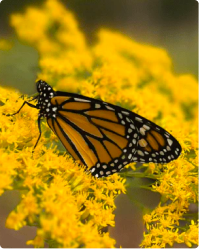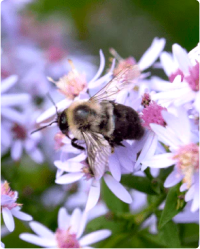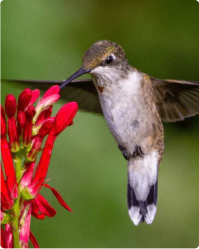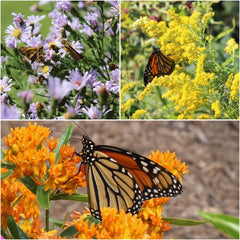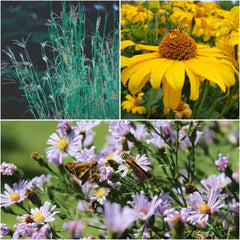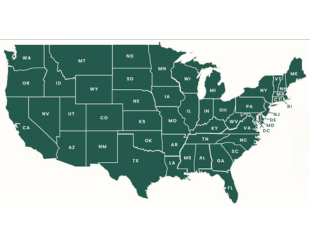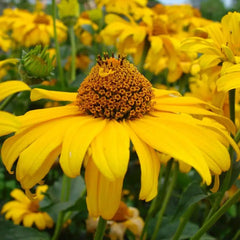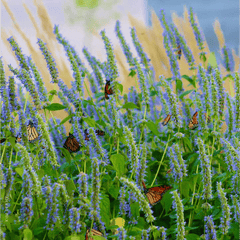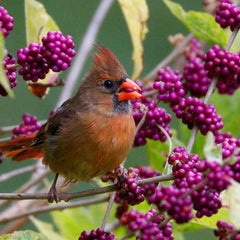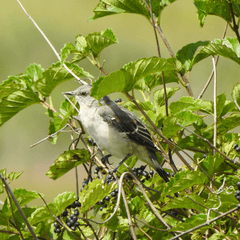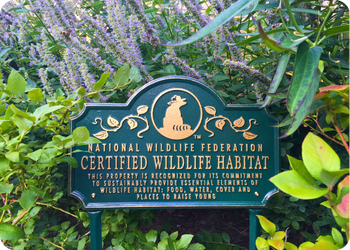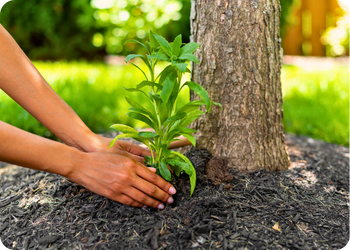Why You Should Buy Native Grasses

Buy Native Grasses: Your Sustainable Lawn Alternatives
The quintessential lush lawn is evolving, with many homeowners and garden enthusiasts turning towards native grasses. These grasses not only add unique textures and colors to your landscape but also promote biodiversity and require less maintenance. With movements like No-Mow May and the anti-lawn movement gaining traction, it's the perfect time to explore the array of native grasses available for sale.
Meet the native grasses
Discover the charm and benefits of the following native grasses, which are not only visually appealing but also eco-friendly and low-maintenance.
Little bluestem grass
The little bluestem, scientifically known as Schizachyrium scoparium, is a native grass that brings a mix of color and texture to your garden. Growing to a height of 1.5 to 4 feet, with a spread of 1.5 to 2 feet, this grass is a visual delight from June to December when it blooms. Its blue-green hue during spring and summer transitions to a deep reddish-brown in fall, offering a dynamic display throughout the seasons.
This variety of native grass for sale is particularly hardy, with the ability to thrive in a range of soil types, including loam, clay, sandy, and limestone. It prefers a medium to dry soil moisture level and revels in full sun. What sets the little bluestem apart is not just its visual appeal but also its role in the ecosystem. It attracts a huge range of wildlife, including caterpillars, native bees, birds, and fireflies, becoming a lively focal point in your garden.
Offered in sets of three, six, or twelve plants, the little bluestem is a choice that’s as environmentally responsible as it is beautiful. Their deer-resistant nature, low water requirement, and absence of need for chemicals once established make them a low-maintenance, high-reward choice for any garden enthusiast.
Take a closer look at the little bluestem here.
Side oats grama grass
The side oats grama, or Bouteloua curtipendula, is a unique native grass with a quaint charm. Standing at a height of 1.5 to 3 feet and spreading 1.5 to 2 feet, this short perennial grass is a deep-rooted prairie beauty. The flowering period of July to August brings forth interesting orange/red flowers that elegantly hang along one side of its stems, dancing with the wind and adding a touch of whimsy to your garden.

Adaptable to full sun or part shade, the side oats grama is part of our Grassy Gala Plant Collection, and it’s a resilient choice for various landscapes. Its soil preferences range from clay and sandy to rocky, showcasing its versatility. This grass is not just a pretty face, either. Its deep fibrous root system aids in soil stabilization, making it a popular choice for prairie restoration and erosion control projects. The added benefit of attracting caterpillars, birds, and fireflies makes it a lively addition to your outdoor space.
The side oats grama blends well without overcrowding, making it a tasteful companion to other native plants in your garden. Its drought-tolerance and deer-resistant nature further reduce maintenance efforts, making it a favored choice for those looking to enjoy a beautiful garden without the hassle.
You can find side oats grama and other native plants in our Grassy Gala Plant Collection.
Purple lovegrass
The allure of Purple lovegrass, scientifically known as Eragrostis spectabilis, lies in its splendid color display. This native perennial grass transforms into a visual spectacle as summer progresses. The foliage turns purplish-pink, setting the stage for the airy reddish-purple flowers that rise above, creating a cloud of color that’s sure to captivate any observer.

Thriving in full sun, purple lovegrass is quite forgiving when it comes to soil types, being comfortable in sandy or gravelly grounds with medium to dry soil moisture. The non-GMO cultivation and absence of harmful neonicotinoids ensure that your garden remains a haven for pollinators. With its deer-resistant trait and low water requirement post-establishment, this grass epitomizes low-maintenance gardening while delivering high aesthetic value.
Available in sets tailored to your needs, purple lovegrass is a choice that echoes the call for sustainable gardening. The return of this grass year after year not only means less work but also a recurrent display of color and texture that enriches your garden.
Supporting a variety of wildlife, including birds, butterflies, moths, and bees, it’s a step towards creating a balanced and lively garden ecosystem.
Find out more about purple lovegrass and how this grass can transform any garden space.
Prairie dropseed
The prairie dropseed, or Sporobolus heterolepis, is a native grass that combines fine texture with robust ecological benefits. Growing to a height of 2 to 3 feet and spreading equally wide, its arching fountain-like mound of foliage creates a graceful, flowing appearance in your garden. The transformation of its foliage into shades of gold and bronze in fall and winter adds a layer of visual interest, making it a year-round attraction.
Adapted to a variety of well-drained soils and conditions, prairie dropseed thrives in full sun and doesn’t shy away from dry, rocky, or clay soils. It’s a drought-tolerant grass, and its deep roots aid in soil stabilization, making it a practical choice for erosion control or rain garden peripheries. The mid to late summer blooms bring forth small pink and brown-tinted flowers, adding a subtle charm to its already appealing silhouette.

Prairie dropseed's ecological contributions are highly valuable as well. It’s a haven for birds and other wildlife, providing shelter and food, while its aromatic flowers, described to have a fragrance reminiscent of coriander, licorice, or popcorn, add a unique sensory appeal to your garden.
Prairie dropseed is a low-maintenance, high-reward addition to your landscape, promoting a sustainable and captivating garden experience.
Discover more of the benefits of the amazing prairie dropseed.
What is Kentucky bluegrass?
Kentucky bluegrass has long been a popular choice for lawns due to its fine texture and rich color. However, its popularity is starting to wane, largely because it's not without its downsides:
- Shade tolerance: Kentucky bluegrass struggles in shaded areas, requiring full sun to partial shade to thrive.
- Drought tolerance: Its shallow root system requires more water, especially during summer months, compared to other cool-season grasses.
- Maintenance: The higher maintenance and water requirements of Kentucky bluegrass can be off-putting for those seeking a low-effort lawn.
This grass species, though non-native, has become so pervasive that it's often deemed naturalized, yet its dense turf and invasive nature can hinder biodiversity and the growth of other plant species.
Embrace the change with “No-Mow May” and the anti-lawn movement
The No-Mow May and anti-lawn movement are environmental initiatives that encourage individuals and communities to adopt sustainable lawn care practices. Below is a detailed explanation of these movements, along with their origins.
No-Mow May
Originating in the UK, the "No Mow May" movement was started by a group of environmentalists from the organization Plantlife. It has since gained traction in the US, with numerous cities participating. The core idea of No-Mow May is to abstain from mowing lawns during May, allowing flowers to bloom, which in turn supports early-season pollinators.
This is seen as a response to the adverse impacts of lawn mowing, such as wasting water and using fossil fuels, as well as contributing to the decline of pollinator populations. And don’t even get us started on plastic grass, which we think should be banned.
The anti-lawn movement
Also known as rewilding, the Anti Lawn Movement has been growing in popularity, especially on social media, as it encourages the adoption of eco-friendly alternatives to traditional grass lawns. The movement is centered on allowing wilderness to take over once again, thus encouraging wildlife into yards and boosting local ecosystems.
The movement advocates moving away from traditional gardening towards free growth with occasional trimming and tidying to maintain the yard. This movement encourages homeowners to replace traditional grass lawns with more sustainable, low-maintenance landscaping options such as native grasses to reduce water usage, minimize chemical inputs, and create spaces that require less upkeep while still being beautiful and enjoyable.
The recent surge in this movement — one which Garden for Wildlife actively supports — the anti-lawn movement is attributed to increasing awareness among gardeners, landscapers, and homeowners about the environmental repercussions of maintaining traditional lawns, especially in the face of challenges like droughts, which have been driving up water costs in certain regions.
Both movements align with a broader global trend towards eco-friendly gardening and lawn care practices that support local wildlife, conserve water, and promote a harmonious relationship between humans and their surrounding natural environment.
Through such initiatives, individuals can contribute to environmental conservation while enjoying the aesthetic and ecological benefits of native vegetation in their outdoor spaces.
How to buy native grasses
Ready to make the transition? It’s simple to buy native grasses online. Explore our curated collections and find the perfect set of native grasses for your garden. With a variety of native grasses for sale, you’re sure to find the ideal fit for your outdoor space.
Transitioning to a native grass lawn
Starting with a small patch, you can gradually replace traditional lawn grasses with native varieties. Embrace the change, reduce your lawn maintenance chores, and enjoy a garden that’s as pleasing to the eye as it is to the environment.
Embrace the green renaissance and transition to native grasses
Escape the monotonous green carpet and embrace the textured, colorful tapestry that native grasses offer. Buy native grasses online and join the movement towards sustainable, beautiful, and wildlife-friendly lawns. You can also check out our other blog post, Beyond Flowers: Enhancing Wildlife Gardens with Native Grasses.
Ready to transform your garden? Explore our online store, buy native grasses, and start your journey towards a low-maintenance, eco-friendly lawn today. You can also sign up for our free newsletter and get a first look at our new native plants and grasses, plus insights and tips from the team of experts at Garden for Wildlife.
**
Sign up for special offers and updates on plants that help wildlife where you live.
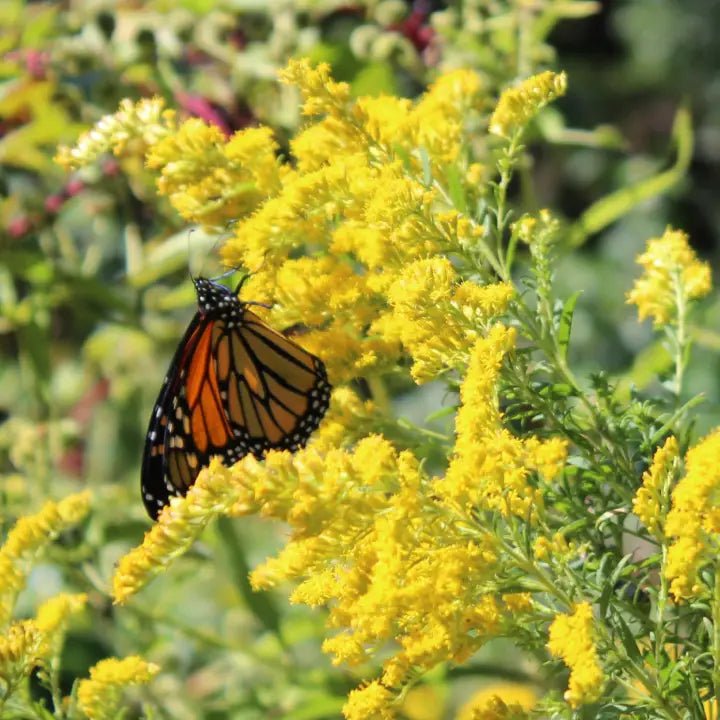
Find Native Plants by Zip Code
We took the guesswork out of planting native. Check your zip to see what ships!
